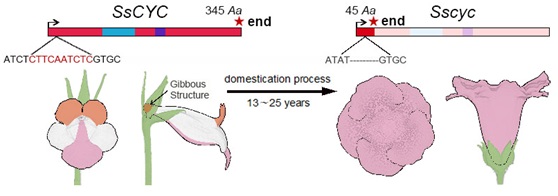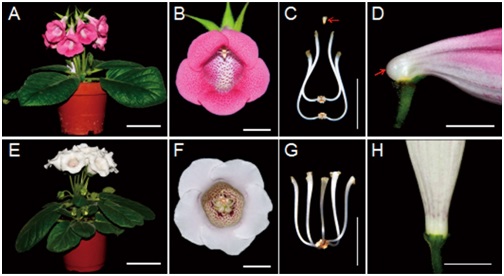
The gloxinia (Sinningia speciosa), a tropical gesneriacious plant, was exported from Brazil and domesticated in Great Britain early in the 19th century for its large attractive peloric flowers, known as Darwin's peloric gloxinia.
Distinct from the wild progenitor with nodding zygomorphic flowers that is adapted to insect pollination, the peloric varieties produce up-right actinomorphic flowers. How such a combinatory character evolved in response to artificial selection is currently not understood.
Research group led by Prof. WANG Yinzheng from State Key Laboratory of Systematic and Evolutionary Botany, Institute of Botany of the Chinese Academy of Sciences, employed multiple experimental approaches to explore the genetic mechanism underlying the evolution of peloric phenotype in domesticated gloxinia.
The results have been recently published in a paper in Molecular Biology & Evolution online with a title "Evolution of Darwin's peloric gloxinia (Sinningia speciosa) is caused by a null mutation in a pleiotropic TCP gene".
They found that the horizontal orientation of the flower is caused by a ventral-dorsal asymmetric growth at the base of dorsal corolla which produced a convex, gibbous structure.
They further showed that the development of gibbous structure was caused by the asymmetric expression of SsCYC that has also a dorsal-specific expression in floral organs. SsCYC encodes a TCP transcription factor with an implicated function in repressing cell growth.
They have characterized a 10-bp deletion in the coding sequence of the gene Sscyc that results in the production of a non-functional truncated protein with 45 amino acid (aa) in length.
They demonstrated that this mutation was causally responsible for the development of peloric flowers in gloxinia.
The putative ancestor of modern peloric gloxinias was further traced back to a particular wild collection from Rio de Janeiro State in 1820 (Gloxinia caulescens, now a synonym of Sinningia speciosa) by literature review, and genetic inference combined with phylogenetic analysis.
Their results show that one mutation in a single gene causes a complex morphological shift from a horizontally orientated, and zygomorphic flower, to an upright, actinomorphic form in gloxinia.
The findings suggest that pleiotropy may play a crucial role in the coordinated evolution of complex floral organs in angiosperms.
This work is funded by the National Natural Science Foundation of China and the Financial Grant from the China Postdoctoral Science Foundation.

Figure 1. The molecular mechanism underlying the nodding zygomorphic flower of wild gloxinia and the domestication model of the peloric gloxinia (Image by WANG Inzheng)

Figure 2. Phenotypic analysis of flower character in the wild-type and cultivated peloric gloxinia (Image by WANG Inzheng)

86-10-68597521 (day)
86-10-68597289 (night)

86-10-68511095 (day)
86-10-68512458 (night)

cas_en@cas.cn

52 Sanlihe Rd., Xicheng District,
Beijing, China (100864)

